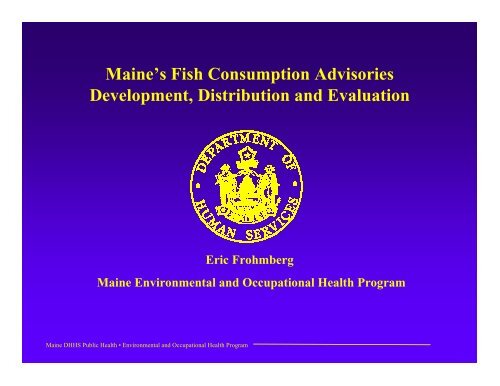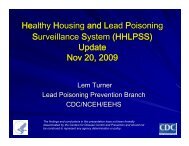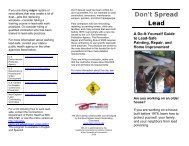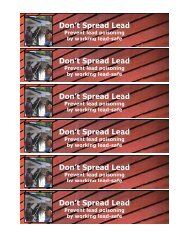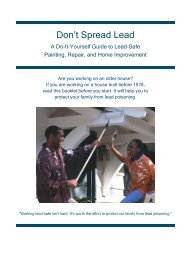by Eric Frohmberg
by Eric Frohmberg
by Eric Frohmberg
Create successful ePaper yourself
Turn your PDF publications into a flip-book with our unique Google optimized e-Paper software.
Maine’s Fish Consumption Advisories<br />
Development, Distribution and Evaluation<br />
<strong>Eric</strong> <strong>Frohmberg</strong><br />
Maine Environmental and Occupational Health Program<br />
Maine DHHS Public Health • Environmental and Occupational Health Program
Outline<br />
Problem Analysis<br />
Audience Needs<br />
Assessment<br />
Formative<br />
Evaluation<br />
Communication<br />
Strategy Design<br />
Communication Strategy<br />
Implementation<br />
Process<br />
Evaluation<br />
Summative<br />
Evaluation
Fish and Mercury Basics<br />
ALL FISH have some<br />
mercury in them.<br />
Dominant concern for mercury is the developing ba<strong>by</strong>.<br />
Fish is also good for you – communicating a conflicting message
What do we know?<br />
• Current exposures are significant<br />
Women 16-49<br />
(1999-2000 NHANES)<br />
Blood Hg (ug/L) n=1709<br />
75 th<br />
25 th 90 th<br />
0.4 0.9 2.0 4.9 7.1<br />
95 th<br />
50 th EPA RfD=3.4<br />
• Only 31% Maine women of childbearing age aware<br />
of mercury advisories (WI/ME 12-State RDD Survey, 2000)
Audience Identification<br />
Who do we want to Reach?<br />
• Pregnant women<br />
• Women who may get pregnant<br />
• Women who are nursing<br />
• Children under 8<br />
Techniques to Reach Them<br />
• Birth Registry Database ∩<br />
Sport Fishing License<br />
Database<br />
• 40% of Pregnancies in<br />
WIC<br />
• OB/GYN, Family Practice,<br />
and Pediatricians<br />
A lot more to Audience Identification
Audience Identification<br />
• Approximately 50% of U.S. adults read at or<br />
below 8 th grade level.<br />
• Reading level decreases with increasing poverty,<br />
age, illness, and stress.<br />
• In 1994, 80% of health care materials distributed are written<br />
at a level that only 3% of adults can easily read.<br />
Source: National Adult Literacy Survey of 1993<br />
Riffenburgh and Associates 1994
Technique: Writing “Plain Language”<br />
• Grade Level - Use readability analysis.<br />
• Content -Tell them what the need to know, not nice<br />
to know. Remove jargon. Conversational tone. Active<br />
voice.<br />
• Layout – effective use of graphics, plenty of white space,<br />
appropriate typeface (limit sans serif and ALL CAPS).
How People Scan Text<br />
People scan the top ½ of the line<br />
For that reason it is harder to read<br />
sans serif<br />
AND HARDER TO READ ALL CAPS
Evaluate: Focus/Key Informant Group Testing<br />
Hints<br />
• Find existing groups to use.<br />
• ~6-8 People. Recommend a moderator and a note taker.<br />
• Plan your questioning route – start broad, then focus.<br />
• Reimburse participants for their time – gift certificates,<br />
payments, gifts.
Example: What did we learn?<br />
Before<br />
After
Writing to Different Audiences
Tables versus Charts
Distribution<br />
Develop New “Easy to Read”<br />
Brochure<br />
Targeted Delivery<br />
Target Mailings<br />
• Linkage of Fishing License Database<br />
& Birth Certificate Registry<br />
WIC Clinics<br />
• In Maine, WIC sees ~40<br />
of all pregnancies<br />
Health Care Providers<br />
• OB/GYN Doctors<br />
• FPs and GPs who perform OB<br />
• Nurse Midwife
Evaluation: 4 myths<br />
Evaluation is too complicated, no one here knows how to do it.<br />
Evaluation takes too long.<br />
It is too risky. What if it shows our funding source that we<br />
haven’t succeeded?<br />
We affected only 30% of our intended audience – our program is<br />
a failure.<br />
Source: NCI 2002. Making Health Communication Programs Work.
Evaluation – What is your baseline?<br />
Baseline Survey: 1999 – to assess existing knowledge of<br />
advisories<br />
Evaluation Survey 2000 – to assess impact of brochure<br />
Percent<br />
50<br />
40<br />
30<br />
20<br />
10<br />
32<br />
41<br />
35<br />
Are 26you aware your state has<br />
advice for consuming fish?<br />
0<br />
Maine<br />
Wisconsin<br />
1999 2000
New Moms Survey: Design/Methods<br />
• 24 pages, 75 questions<br />
• Pre-tested<br />
•Mail survey<br />
• Sample drawn from Birth<br />
Certificate Registry<br />
• ~60% response rate (n=768)<br />
• Asked for hair sample
Survey: Helpful Hints<br />
• Data analysis plan<br />
• Identify data sources for key comparisons<br />
• Think about evaluation during design of materials<br />
• Identify goals – what is a “success”?
Comparison of Studies<br />
1998/9 Pre-Survey<br />
2000 Post Survey<br />
2004 Moms<br />
Target Pop<br />
Women of<br />
Childbearing Age<br />
Women of<br />
Childbearing Age<br />
Moms<br />
Sample Size<br />
535<br />
493<br />
768<br />
Mean Age<br />
34 ± 7.5<br />
34 ± 8.6<br />
27 ± 5.7<br />
Race<br />
95% white<br />
96% white<br />
96% white<br />
Fishing Lics<br />
39%<br />
40%<br />
44%<br />
Aware State<br />
Has Advice<br />
32%<br />
41%<br />
60%
How do you measure success?<br />
Awareness that the state has advice up to 60%<br />
31% of the total sample reported getting our brochure<br />
Of the total sample only 6.5% ate any “forbidden fish” in last 3<br />
months of pregnancy<br />
Of those who got brochure, 93% reported reading it.<br />
Of those who got brochure, 64% had a HCP talk to them about<br />
the information in it.
Measuring Success, Cont’d<br />
Ate fish and got<br />
brochure<br />
Ate fish and didn’t<br />
get brochure<br />
p value<br />
Ate White Tuna<br />
54% (48-60)<br />
64% (59-68)<br />
0.02<br />
Ate Light Tuna<br />
39% (33-46)<br />
30% (25-35) 0.02
What can we say about distribution?<br />
31% of the total sample reported getting our brochure<br />
Of the total surveyed population<br />
•4% in mail<br />
•24% from Doc/CNM<br />
• 9% got it from WIC<br />
41% of the sample were on WIC<br />
• 29% of those in WIC remember getting it from WIC
Distribution: Cont’d<br />
Education
What can we say about the population?<br />
1999 Women<br />
OCB<br />
2000 Women<br />
OCB<br />
2004 Moms<br />
Before Pregnant<br />
2004 Moms<br />
Last trimester<br />
Ate any<br />
sportfish<br />
21%<br />
21%<br />
14%<br />
5%<br />
Of those who ate fish in last trimester, only 13% ate more than 2<br />
meals per week.
This is an iterative process: New Draft Brochure
Cost?<br />
• ~$13,000 for first brochure<br />
• ~$6,000 for distribution<br />
• ~ $15,000 for evaluation<br />
• ~ $15,000 for redesign
For more information:<br />
• Low Literacy Communication Skills for Health Professionals:<br />
Biddeford, ME; Albuquerque, NM:<br />
http://www.healthliteracyinstitute.net/<br />
• Focus Group Interviewing Workshop, Minneapolis, MN: email<br />
Richard Krueger at: rkrueger@tc.umn.edu<br />
• Krueger, R.A. and M.A. Casey. 2000. Focus Groups: A Practical<br />
Guide for Applied Research. 3 rd Ed., Sage Publ.<br />
• NCI. 2002. Making Health Communication Programs Work. NIH<br />
Publication No. 02-5145. FREE at 1-800-4-Cancer<br />
http://www.cancer.gov/pinkbook<br />
• CDCynergy 3.0 Your Guide to Effective Health Communication.<br />
http://www.cdc.gov/communication/cdcynergy.htm


